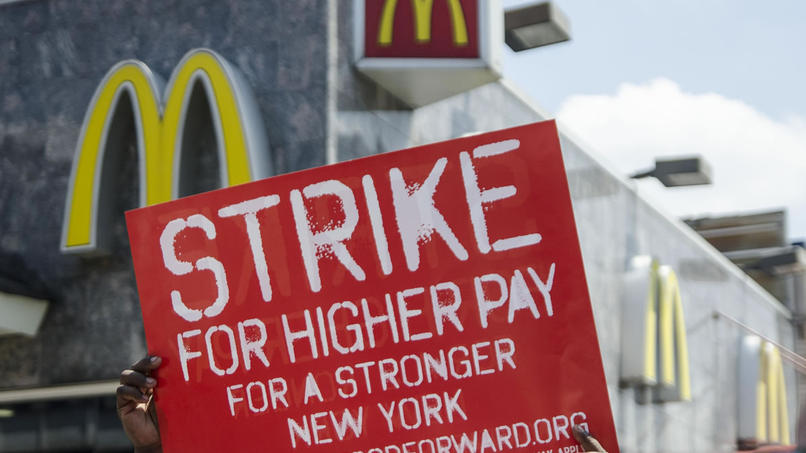

Share
Are mass movements of low-wage workers, under slogans such as “Fight for 15 and a union,” the future of organizing? The answer, two expert labor lawyers believe, is “Yes.”
Judith Scott, general counsel for the Service Employees International Union, and Richard Griffin, general counsel – and top enforcement official – for the National Labor Relations Board, welcome it.
But lobbying and legislation to empower the low-wage workers must accompany those movements, they add. Otherwise, the momentum they have built – and are building – will fall.
Griffin and Scott offered their views on the future of organizing at a recent symposium on labor law in Washington, D.C. Both have had long careers standing up for workers’ rights and can remember when private-sector union density was far above the current figure of 6.7 percent.
“Fight for 15 started with 200 fast-food workers in New York City in November 2012” walking out of their restaurants in a strike over low pay, lack of respect and the right to unionize without employer interference, harassment or law-breaking, Scott said.
“Now, it’s spread to thousands of workers in at least 30 cities and to solidarity from other workers in six foreign countries,” she added. And it’s gotten results: Raises in minimum wages at the state and local level nationwide, including $15 minimums in Seattle, its Sea-Tac suburb and New York City, “and even in some Southern cities,” she notes.
“But we didn’t send people into small cities in Arkansas, and we were getting calls from” fast food workers there, Scott said. “They told us, ‘We’re on strike. What do we do now?’”
The mass movement, which Scott says also “restored the right to strike,” did not succeed in the traditional manner, she noted. Instead of pushing employers to the bargaining table first – via union recognition followed by contract negotiations – it forced them to yield what workers wanted, through legislation and lobbying.
Thus the fast food workers in New York not only benefited from a city ordinance, but also, thanks to the political pressure from the mass movement and from SEIU, which backs Fight for 15, and allied unions, from a new state commission investigating low-wage industries. That panel, named by Gov. Andrew Cuomo, declared fast-food as the first industry whose workers deserved a new and higher state minimum wage.
Griffin cited a similar movement of Wal-Mart workers, which at least has forced the monster anti-worker retailer to pay attention to its employees and even raise some wages. But that movement, too, has been outside traditional labor law, he noted. Wal-Mart is so anti-worker that the NLRB, including regional officials, has convicted it at least 288 times of breaking labor law as the United Food and Commercial Workers tried to unionize it.
But those convictions carried little impact with the retail monster, forcing it only to cough up net back pay and post “we won’t do it again” notices in its stores and warehouses – notices it then disregards with impunity.
That tells Griffin “the National Labor Relations Act has not necessarily been flexible enough to accommodate workers.” The Wal-Mart workers’ campaign, however, has also “had the objective of establishing national standards of wages and hours.”
Still, if the Wal-Mart workers choose to do so store by store – the U.S. Supreme Court several years ago barred them from a mass class action suit on wage and promotion discrimination against female workers – the process is slow and fraught with obstacles, he admits. “There’s a steady stream of cases, and handling them efficiently is a challenge,” he adds.
That’s why the nationwide mass movement, and the strikes it produces, is so important, he adds. But so is the legislation that empowers the workers, and in the absence of a rewrite of the NLRA – blocked by big business and the Republican-run Congress at the start of Democratic President Barack Obama’s term – that’s the way to go, Griffin states.
“We’re starting to see tripartite bargaining, where workers don’t have to be restricted to a small collective bargaining table,” covering one union and one employer, he explains. “You have the public involved with an industry” and its standards, or lack of them, and you get results such as Cuomo’s board on low-wage industries, he notes.
“That didn’t put people on the streets,” he said of a recent board session in Buffalo “but there were 250 witnesses,” extensive media coverage which brought the issue of low wages and lousy working conditions to public attention “and the result was workers and employers bargaining in public.”
Fight for 15 and a union is not the only mass movement out there of restless workers, or citizens, Griffin noted. It shares the same strategy and mobilization tactics with Black Lives Matter, the environmental justice movement, and campaigners for LGBT rights, including workplace rights. Sooner or later, he predicts, all four movements “will have a convergence on their issues,” with all four supporting each other.
“It’s important not to suffer from a lack of imagination,” Scott said. “What we’re looking at is a large service sector,” including fast food workers, retail workers, port truckers, Wal-Mart workers, warehouse workers, home health care workers, and adjunct professors “which is suffering the same challenges the industrial sector had” in the 1930s.
“We’re going to have to addressed that legally – and with different models” of organizing, she adds. Employers fight back in legislatures and in courts, but that shouldn’t stop the workers, Scott warns. “At SEIU, we say no court case will stand in the way of workers changing their own lives.”

